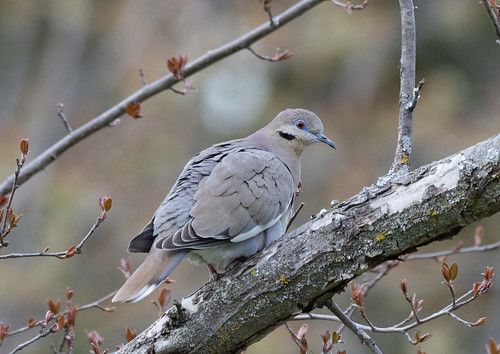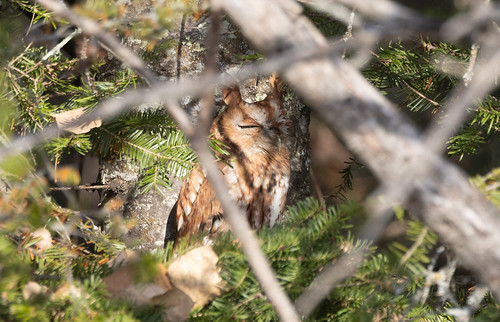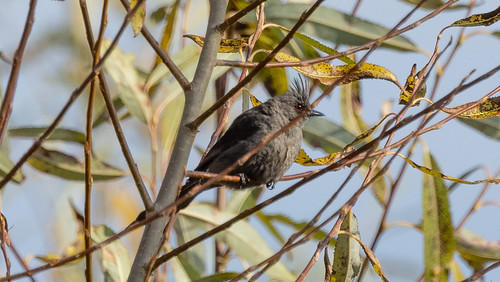On May 17 this year, I saw a Field Sparrow in my yard. This is a common bird over much of the eastern United States and Canada, Duluth is within its breeding range, and I’ve seen quite a few in the state, but it doesn’t turn up here very often and this was a new bird for my yard list, so I sent out an alert in case any other local birders wanted to see it.
A few hours later, when I was babysitting my grandson Walter at his house 3 miles away, I received a text message from Bruce Munson about a much rarer bird that was right that minute in my yard—a White-winged Dove.
Ironically, Bruce lives next door to my grandson, but at that moment he was sitting in my backyard looking at a bird I’d never seen anywhere in Minnesota before. Thanks to the alert, I got home in time to see it, a bird that would never have been noticed at all had not a bunch of birders been in my yard looking for my Field Sparrow.
Something similar happened this weekend. On Saturday morning, Jim Lind found a gorgeous Eastern Screech-Owl roosting tight against the trunk of a spruce tree close to the main parking lot at the McQuade boat landing and got the word out. I missed Jim’s original text, but a little while later, Bruce Munson texted me to make sure I knew about it. I’ve only seen a screech owl in St. Louis County once before, way back in 2004, so I grabbed my binoculars and camera and set out.
The last weekend in October happens to be when a lot of good birds turn up along the north shore of Lake Superior, and of course a screech owl is too good to miss. Lots of other rarities have turned up around McQuade over the years, more often on the far side of the smaller parking lot, so as long as they were there anyway, birders were checking that out, too. Sure enough, that’s where Molly Misfeldt and Michael Sack discovered a mega rarity—a Phainopepla! This silky flycatcher of Mexico and the American Southwest does very rarely appear way out of its range. The eBird map shows sightings on Nantucket Island and places near Toronto and Winnipeg, but these outliers are few and far between and never before has a Phainopepla appeared in Minnesota.
Before I was even out of the driveway, hoping for the screech owl, I got a text message about the Phainopepla. When I arrived at McQuade, at least a hundred birders—some local and some from farther away, most here on day or weekend excursions up the shore—were crowded onto Scenic Highway 61. Their spotting scopes, binoculars, and cameras were all focused on one precise spot—a low branch of a dead spruce where the little wanderer was perched in a splash of sunlight.
After getting a bunch of distant photos, I went to the other parking lot to look for the screech owl and was surprised and delighted to discover that it was a red, or rufous, morph. The gray form is far more common in the upper Midwest. What a visual treat!
Ethical birders don't dare approach too close to roosting owls. We don't want to alarm them—if they open their eyes wide, they're likely to be noticed by chickadees whose alarm calls will alert other birds. I've seen both robins and Blue Jays draw blood when mobbing tiny owls. So I stayed in the parking lot, not getting any closer to take photos. Some people feel that an expensive camera with a long lens somehow justifies getting really close to a bird, but the way I see it, my expensive camera and long lens help me get decent pictures while staying at a respectful distance.
After I'd taken several photos, I headed back to spend more time with the Phainopepla. I spent an hour and a quarter at McQuade in total, going back and forth between the two birds. The screech owl stayed put, but the Phainopepla left its perch several times to feed on buckthorn berries and once alighted in a willow where it preened for a bit, but it kept returning to the same spruce branch.
I helped some newcomers see the birds and explained to a few passersby on Scenic Highway 61 what all the commotion was about, but I was so focused on the birds that it didn't occur to me to take a photo of the crowd.
I felt joyful heading home—the birds had been thrilling to see, I was reasonably happy with my photos as far as documenting the rarities went, and most of all, it was so rewarding to share these splendid birds with so many other birders, on the receiving end when people told me where they were to begin with, and then on the giving end as other people arrived.
I take so much pleasure in seeing my favorite backyard birds over and over, and so much satisfaction in birding alone—walking or just sitting in lovely places and quietly communing with whatever birds' paths cross mine, not needing to talk to people at all. But even an introvert like me likes to spend some time with kindred spirits, and nothing beats mingling with a crowd of happy birders, every one of us sharing such a joyful experience.









